In February of 2021 –as the world began to recover from the shutdown caused by COVID-19– I was briefly able to set up and document a new installation that centered around the second conceptual theme of my research as a sex laborer: the use of tools outside of their intended purpose. The installation that comprised Safe 2, consisted of three videos that I shot during the COVID shutdown. They are each approximately 30 minutes long and consist of a single shot of me wearing the black jump jumpsuit, sitting at a white table, and “using” a yellow tool. Large versions of the videos were looped and projected onto three separate walls in the gallery.
The first video, Touch, begins with the camera fading into a scene of a yellow table saw blade extended through the top of the white table and set in front of a white wall. The table saw is turned on and the blade begins spinning. I then enter the scene and slowly extend my left index finger to touch the middle of the spinning saw blade. My finger remains in contact with the blade for about 25 minutes. I then withdraw my hand, exit the frame, the machine turns off, and the camera fades out. As my finger withdraws from the frame, the viewer is able to see a yellow mark and blister on my finger caused by the abrasion of the saw’s contact with my body. The second video is called Suck. The camera fades into a similar scene consisting of a yellow industrial-style vacuum on top of a white table. The machine turns on, I enter the frame, and I take the end of the vacuum’s tube and place it on the front part of my right neck. I remain still for about 25 minutes and then pull the tube away revealing a round purple hickey on my neck. I then exit the frame, the machine turns off, and the camera fades to black. The final video is similar in structure and is called Kiss. This time there’s a yellow battery-powered drill with a long drill bit inserted into its head on the white table. I enter the frame, pick up the drill, and maneuver its trigger into my mouth. Then using my lips, tongue, and teeth, I activate the trigger, setting the drill into motion while the drill bit spins next to my left ear. I remain like this for about 25 minutes until the battery of the drill dies. I then place the drill back on the table, exit the frame, and the camera fades to black. The result of this action leaves a pool of drool and saliva on the surface of the table and covering the bottom half of the drill. Aside from the three video projections, the only other object in the room was a behind-the-scenes photograph of myself working as a sex laborer, on my knees in front of a standing male dominant and a reclined female submissive. The physical posturing of my body is literally “in-between” that of dominant and the submissive. The yellow drill used in the video can be seen in the foreground of the frame.
Like the videos that I made to deconstruct my old uniform, all of these tool pieces are shot in the same classically styled, completely illuminated, single point, studio-based, performance-shot-for-the-camera fashion. Like before, this was an illusion and the videos were shot outdoors in front of a faked studio set. If given a careful examination viewers will begin to notice ambient noises only found in outdoor settings.
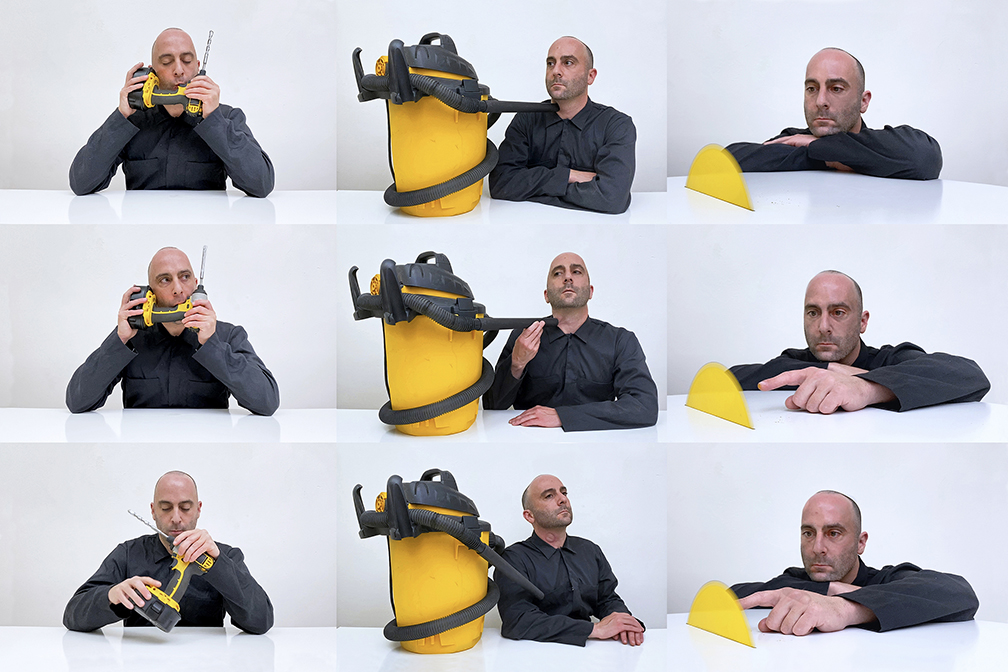
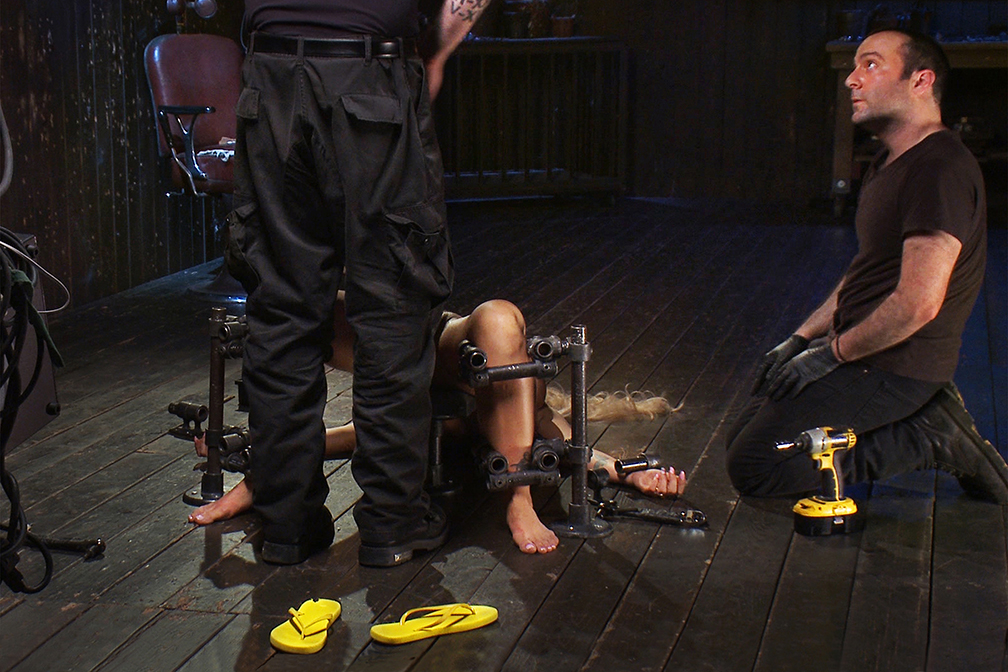
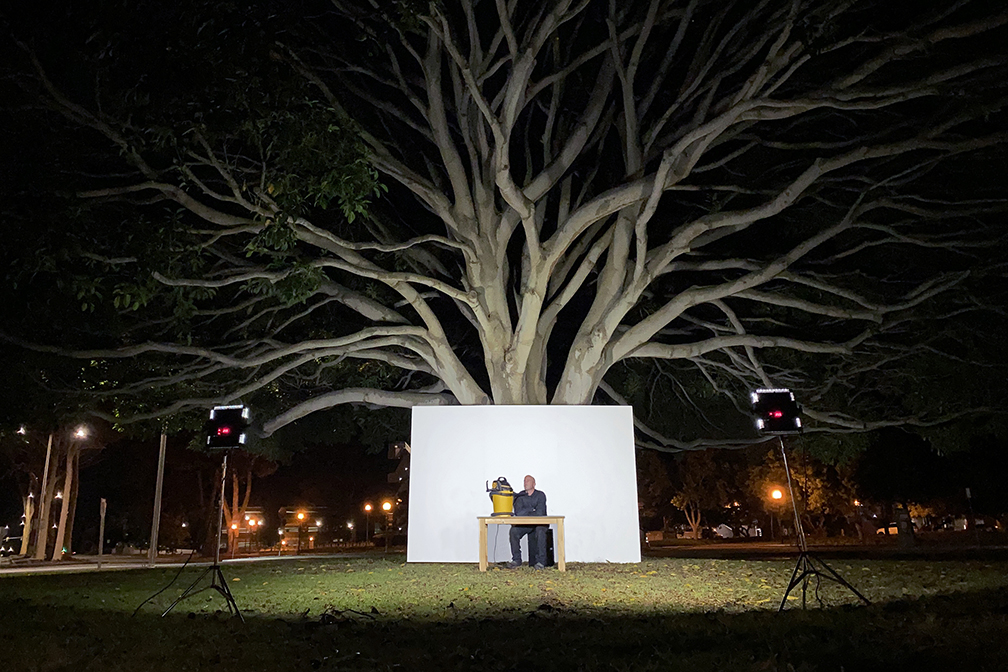
In a separate glassed enclosed room, I constructed a live isolated performance called Safe: Blow that could only be viewed from the outside by peering through the gallery’s two large glass walls. Inside of the room, I again set up a white table and placed a yellow air compressor on top. The compressor was turned on, I sat down at the table, and proceeded to use the compressor’s nozzle to blow air into my mouth and expand my cheeks for about 25 minutes. I then left the table and the compressor was turned off.
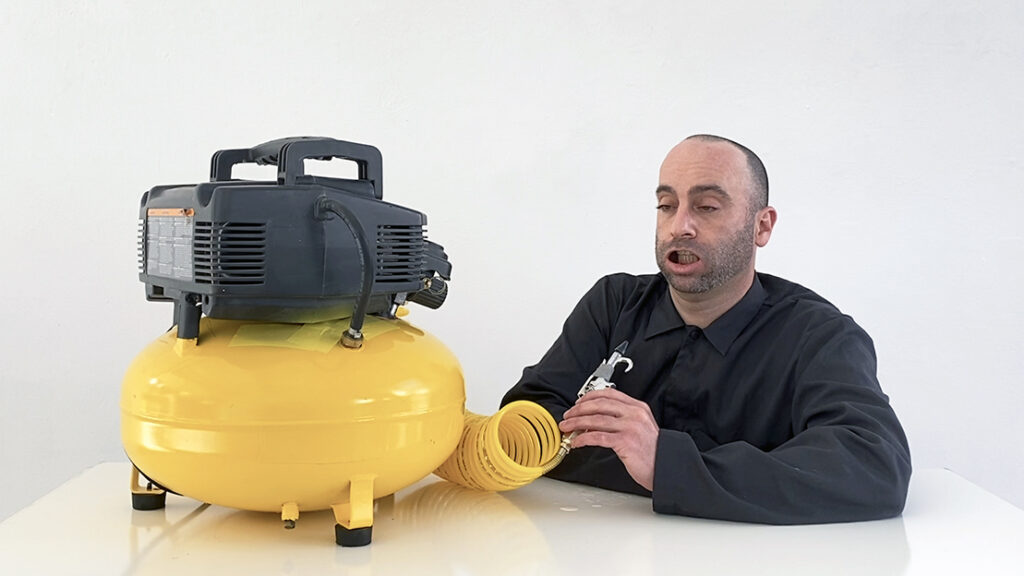
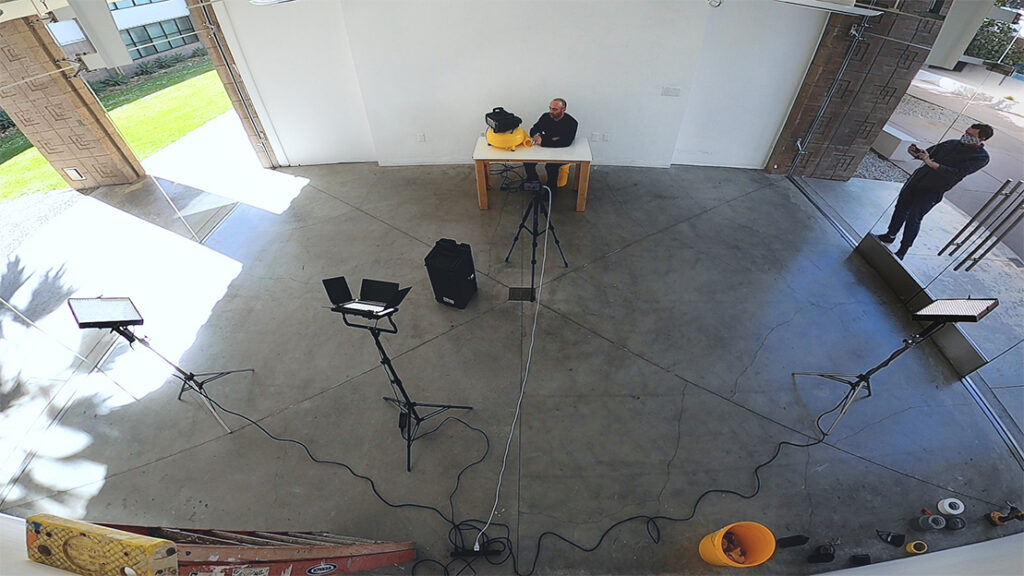
In a third room, there were three wall mounted sculptures on display that showcased the tools used in the videos. Similar to objects that I made to house my articles of clothing, these sculptures were housed in formal, black, gallery shadow boxes with glass fronts. The first shadow box contained the vacuum with the end of its hose sticking out of a holed drilled into the side of the box. The vacuum was activated via a motion sensor whenever a person was within three feet of the shadow box. If a viewer wanted to, they could press their hand or neck against the hose and feel its suction. The second box contained the drill and had a long rod extending from the inside of the box to the outside. Underneath was an open trough containing large rubber balls with metal hexagonal bolts sticking out of one of their sides. If a viewer chose to, they could remove one of the balls and attach it via the hexagonal bolt to a magnetic bit that extended from the drill’s trigger inside of the box. The viewer could then put their mouth on the ball, press in, and activate the drill. Each participant got to keep their ball as a signed souvenir of the experience. Housed within the third shadow box, the viewer could see a yellow, circular saw blade protruding from a white background. The motor controlling the saw blade was hidden in the back of the shadowbox and would activate via a motion sensor whenever a person was within three feet of the box. This way an audience member was aware that the machine was on before they were in close proximity to the device. If a person chose to, they could touch the spinning saw blade via thick clear plastic tube that extended from the center of the blade through a hole that had been drilled into the side of the shadow box. Due to the design of the and placement of the tube, a person’s finger was never in any danger of being cut by the saw. Like the sculptures made about my uniform, these three of the sculptures again appeared as if they were escaping from the sterile and safe confines of the shadow box. As before, this process brought a viewer into direct contact with tactile objects that they at first were only able to indirectly experience while watching the videos.
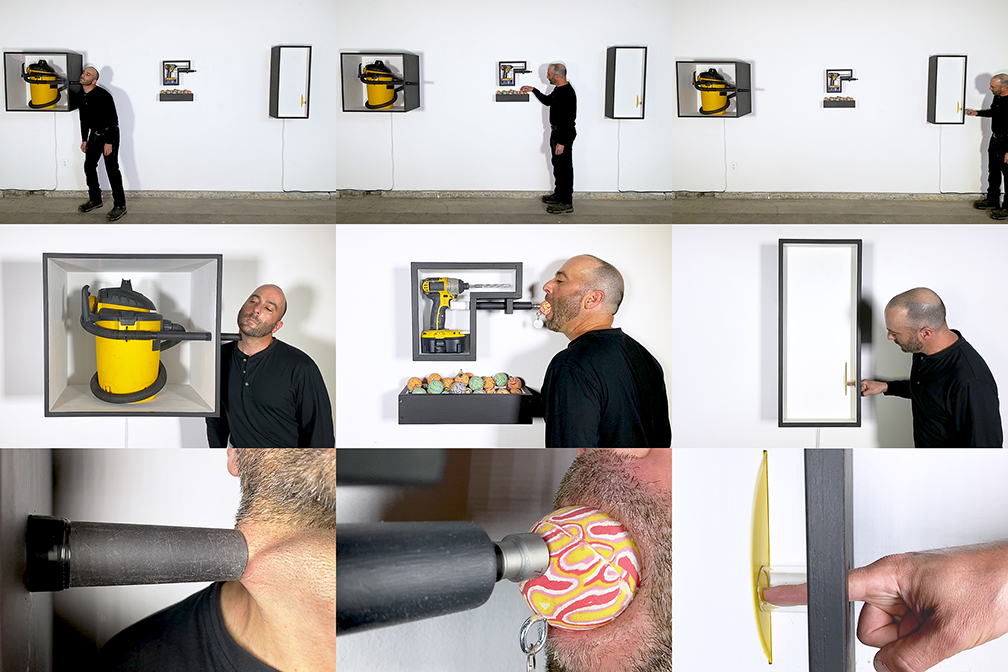
Since 1999, I have been using my jobs as research to inform my art practice. Having completed bodies of work regarding my professional careers as a cabinet maker, fine-dining busboy, locksmith, and yoga instructor, I most recently –from 2010-2018– worked behind the scenes helping to produce adult bondage and fetish movies as a full-time hourly employee. As a worker in this industry, my job title is often referred to as an “engineer” or a “rigger.” This entailed constructing or assembling the bondage in which models would be restrained during the filming of the movies. This role encompassed many different tasks; however, my most important responsibility was to create and fabricate safety for everyone on set, with the primary emphasis being placed on the safety of the model who would be in bondage.
When I began to moblize my employment in pornography as part of an art making process, I first had to determine if and how I might be able to ethically make art inspired by this research –as I have done in my other employment experiences– in ways that didn’t objectify anyone. At the outset, I spent a lot of time reflecting, researching, and defining how to situate my role as a worker in this very complicated context. To do this, I created the term “sex laborer.” By authoring this term, I was able to make a distinction between my job responsibilities and that of “sex workers.” Sex work is an identity and a form of employment for which I have tremendous respect, and I make this important distinction between my labor and that of sex workers because although some people in the world view my role in the production of fetish movies as sex work, others in the sex-industry disagree with that notion as I kept my clothes on and rarely appeared on camera. However, there have been other times in my life that my work in pornography has been treated with judgment by people outside of the industry in similar ways to the judgment that is sometimes placed upon sex workers. This left me in a complicated situation that I needed to come to terms with and to find a safe place from which to situate and contextualize my experiences. Complicating this matter further, I –unlike almost all of my co-workers– never assumed a stage-name or “porn-name” in an attempt to shelter my identity. I did this because it felt disingenuous to participate and examine adult films as “research” and then try to hide the fact that I was doing it. Although I stand by the ethics of this decision, this transparency places me in a precarious social position that required me to define an identity as a worker that seemed honest, while also firmly situating myself in solidarity with sex workers all over the world.
The second theme that I explored regarding my work as a sex laborer was the use of tools outside of their intended purpose. By examining this theme, I attempted to recontextualize my experiences with the tools that I used in both my work as a sex laborer and also within my art practice. In each, I sought to show the secret unseen intimacy that I shared with these tools that allowed me to create a context in which intimacy could be transformed into a physical commodity during the production of fetish movies. These projects reify emotional labor and allow it to be transformed into tangible experiences that I can share with an audience through the mediation of video and sculptures. I reached towards the power tools not as a means of production, but instead as partners in an unrequited intimacy which seems not all that dissimilar from a dangerous liaison between a manager and subordinate. I attempted to show a viewer a vantage point that does not easily depict whether it is I or the tool that is the subject of the videos that is asserting dominance over the other. I wanted to display a switching of power that is subtle, meditative, and also very intimate. Within this new and ambiguous intimacy, there is enough room from the audience to feel the experiences reflected in their body while also remaining safe. In light of this re-contextualization, these pieces become linked conceptually by the assertion that tools are often viewed as the servants of people. They perform tasks and are defined by their purpose. In a time of global isolation, I asked my tools, “How can I serve you and how can we make a new meaning together?” By using these inanimate tools outside of their intended purpose, I was able to lay the foundation for the third conceptual arc of my research: An Intimacy of Self.
All of the videos, performances, sculptures, and photographs that comprise Safe: 2, attempt to recontextualize my experience with the tools that I used in both my work as a sex laborer and also within my art practice. In each, I sought to show the secret unseen intimacy that I shared with these tools that allowed me to create a context in which intimacy could be transformed into a physical commodity during the production of fetish movies. These projects reify emotional labor and allow it to be transformed into tangible experiences that I can share with an audience through the mediation of video and sculptures. However, I am certainly not the first person to experience intimacy with their tools. Workers all over the world have been doing this for generations.
More information about this series below:
Since 1999, I have been using my jobs as research to inform my art practice. Having completed bodies of work regarding my professional careers as a cabinet maker, fine-dining busboy, locksmith, and yoga instructor, I most recently –from 2010-2018– worked behind the scenes helping to produce adult bondage and fetish movies as a full-time hourly employee. As a worker in this industry, my job title is often referred to as an “engineer” or a “rigger.” This entailed constructing or assembling the bondage in which models would be restrained during the filming of the movies. This role encompassed many different tasks; however, my most important responsibility was to create and fabricate safety for everyone on set, with the primary emphasis being placed on the safety of the model who would be in bondage.
When I began to moblize my employment in pornography as part of an art making process, I first had to determine if and how I might be able to ethically make art inspired by this research –as I have done in my other employment experiences– in ways that didn’t objectify anyone. At the outset, I spent a lot of time reflecting, researching, and defining how to situate my role as a worker in this very complicated context. To do this, I created the term “sex laborer.” By authoring this term, I was able to make a distinction between my job responsibilities and that of “sex workers.” Sex work is an identity and a form of employment for which I have tremendous respect, and I make this important distinction between my labor and that of sex workers because although some people in the world view my role in the production of fetish movies as sex work, others in the sex-industry disagree with that notion as I kept my clothes on and rarely appeared on camera. However, there have been other times in my life that my work in pornography has been treated with judgment by people outside of the industry in similar ways to the judgment that is sometimes placed upon sex workers. This left me in a complicated situation that I needed to come to terms with and to find a safe place from which to situate and contextualize my experiences. Complicating this matter further, I –unlike almost all of my co-workers– never assumed a stage-name or “porn-name” in an attempt to shelter my identity. I did this because it felt disingenuous to participate and examine adult films as “research” and then try to hide the fact that I was doing it. Although I stand by the ethics of this decision, this transparency places me in a precarious social position that required me to define an identity as a worker that seemed honest, while also firmly situating myself in solidarity with sex workers all over the world.
The second theme that I explored regarding my work as a sex laborer was the use of tools outside of their intended purpose. By examining this theme, I attempted to recontextualize my experiences with the tools that I used in both my work as a sex laborer and also within my art practice. In each, I sought to show the secret unseen intimacy that I shared with these tools that allowed me to create a context in which intimacy could be transformed into a physical commodity during the production of fetish movies. These projects reify emotional labor and allow it to be transformed into tangible experiences that I can share with an audience through the mediation of video and sculptures. I reached towards the power tools not as a means of production, but instead as partners in an unrequited intimacy which seems not all that dissimilar from a dangerous liaison between a manager and subordinate. I attempted to show a viewer a vantage point that does not easily depict whether it is I or the tool that is the subject of the videos that is asserting dominance over the other. I wanted to display a switching of power that is subtle, meditative, and also very intimate. Within this new and ambiguous intimacy, there is enough room from the audience to feel the experiences reflected in their body while also remaining safe. In light of this re-contextualization, these pieces become linked conceptually by the assertion that tools are often viewed as the servants of people. They perform tasks and are defined by their purpose. In a time of global isolation, I asked my tools, “How can I serve you and how can we make a new meaning together?” By using these inanimate tools outside of their intended purpose, I was able to lay the foundation for the third conceptual arc of my research: An Intimacy of Self.